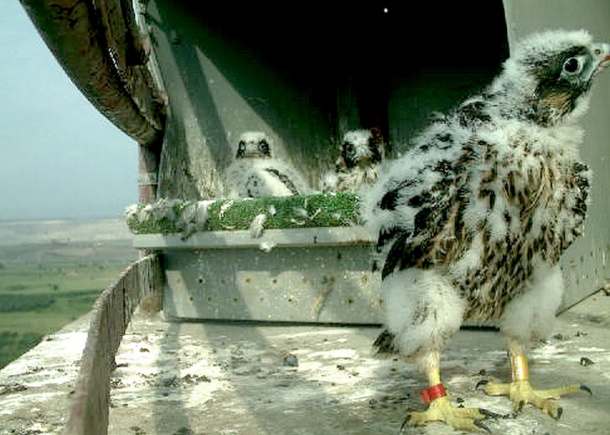Fourteen Peregrine falcon chicks are born on power plant towers

Ornithologist Vaclav Beran: Fourteen young falcons are growing up at power plants across the Czech Republic, all they need now is a little bit of peace
ČEZ Group Press Release
North and Central Bohemia, June 26, 2018 - This year, our falcon pairs are doing well on the towers of ČEZ Group, power station chimneys and cooling towers. Currently, a total of 10 juveniles of this endangered species have hatched in Northern Bohemia and another 4 in Central Bohemia. In 2011, a total of sixty-six chicks hatched when the first aluminium falcon nest boxes were installed across the Czech Republic, including at the Tušimice Power Station cooling tower.
Václav Beran, an orithologist, curator at the Museum of the City of Ústí nad Labem and a researcher from ALKA Wildlife monitors all the nest boxes, with the exception of the nest box located at Tušimické as it is complicated to access. He also organises the ringing of both the adults and the new chicks. He talks about the falcons:
“The only thing that falcon chicks need now is peace. They are all now big enough to either be walking around the towers and they may even be learning to fly and hunt with their parents. It is therefore imperative that the management of all power plants postpone any current or planned activities associated with the towers such as chimney maintenance or climbing exercises by local professional firefighters. Ultimately, the falcon families shouldn’t be disturbed until the chicks have finally fledged the nest boxes for good.”
Peace of mind for falcon nesting is commonplace for power plant directors. Otakar Tuček, director of Tušimice and Prunéřov power plants, talks about how he supports the falcons:
“We were the first to make the installation of the booth to the ornithologists of ALKA Wildlife in 2011. This started their placement in other ČEZ locations. However, in Tušimice there is a booth on the cooling tower, as the chimney was demolished as part of a comprehensive power plant renovation. During the chimney’s dismantling work, three falcon eggs were discovered in one of the galleries on one of the galleries in 2010. We stopped all activities immediately. According to the Nature and Landscape Protection Act, it is forbidden to interfere harmfully with their natural development and to disturb them in specially protected animals. Of course, we have also teamed up with environmental experts. Unfortunately, the ornithologist, Václav Beran, found out that the egg had been abandoned for a long time and had not been fertilized. However, this has confirmed the presence of the Peregrine Falcon in our country. The following year, the falcon couple brought three young men to the booth. Since then, he has a permanent home right in our country and we honor him, ”
Stejný přístup k ohroženému opeřenému predátoru mají pochopitelně i v dalších elektrárnách Skupiny ČEZ. „Rádi jsme vyhověli ornitologům z ALKA Wildlife, zvláště když se před tím snažil sokolí pár hnízdit na skále v sousedství teplárny. I u nás má potřebné podmínky k vyvedení mladých. My se pochopitelně snažíme ho při tom nerušit,“ říká Miroslav Krpec, ředitel Elektrárny Mělník a Teplárny Trmice, na jejímž komíně byla sokolí budka umístěna v roce 2014. Na podzim roku 2015 pak přibyla budka i na ochozech komínů v elektrárnách Mělník a Ledvice.
„Páry v obou lokalitách jsou letos velmi aktivní. Mělnický má čtyři a ledvický tři mladé. Vloni to byl přitom opačný trend. Mělnický sice zahnízdil, ale mladé nevyvedl, a ledvický pár měl jen jedno mládě. Proto v obou případech považuji narození tolika mláďat za velký úspěch. I zde pochopitelně potřebují obě sokolí rodinky absolutní klid. Nejinak je tomu i v Elektrárně Počerady, kde jsem teprve nedávno kroužkoval jedno mládě,“ konstatoval Václav Beran.
„Je to pro nás každoroční záležitost, že v době zahnízdění utlumujeme veškeré aktivity, které se nějakým způsobem týkají komínu. Zahnízdění nám navíc přináší i chvíle napětí, když s kolegy tipujeme, zda bylo úspěšné a kolik mláďat se sokolímu páru podaří ve finále vyvést,“ usmívá se Jiří Kulhánek, ředitel Elektrárny Počerady. Jeho protějšek z Elektrárny Ledvice Jiří Šinágl se navíc pochlubil tím, že vloni vůbec první okroužkovaný sokolí junior v rámci Skupiny ČEZ má domovské právo právě na ochozu jejich komína a jmenuje se Ledvík. Toto jméno mu vybrali v anketě sami zaměstnanci elektrárny a je zaneseno v registraci ALKA Wildlife.
V letech 2011 až 2017 se podařilo ve všech elektrárenských lokalitách Skupiny ČEZ vyvést sokolím párům celkem 52 mláďat, Letos k nim přibude 14 dalších. „T_edy pokud se je podaří rodičům dochovat do jejich samostatnosti,_“ dodává k tomu Václav Beran. Podle ornitologa patří ČEZ bezesporu i mezi průkopníky ochrany sokola stěhovavého v průmyslových lokalitách. Teprve poté následovaly instalace dalších budek na jiných průmyslových stavbách v republice a probíhají dodnes.
Budky jsou na severu Čech na komínech v elektrárnách Prunéřov, Počerady, Ledvice a Teplárny Trmice. Elektrárna Tušimice po modernizaci komín sice již nemá, ale sokolí pár si oblíbil jednu z tamních chladicích věží. Ve středních Čechách mají svou sokolí budku Elektrárna Mělník a nově areál společnosti Energotrans, a. s., v Třeboradicích. „Na jaře zde byl viděn dospělý pár. Vše vypadalo na hnízdění, ale nakonec se ukázalo, že dospělý je pouze samec. Jeho partnerka je ještě nedospělá, zřejmě dvouletá. Takže hnízdění letos ještě nebude, ale na příští roky je to slibné,“ uzavírá ornitolog.
Ota Schnepp

